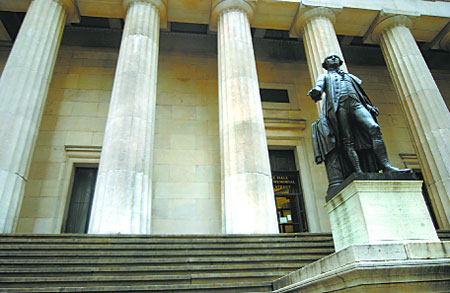By Divya Watal
Federal Hall, site where George Washington took the nation’s first presidential oath, closed Dec. 2 for renovations.
Federal Hall, the striking neo-classical building opposite the New York Stock Exchange on Wall Street, closed its doors on Dec. 2 for extensive rehabilitation.
The site, located at 26 Wall St., housed New York’s City Hall in the early 18th century. Later, in 1789, the first capitol of the U.S. established itself there. The previous Federal Hall was demolished in the 19th century and replaced by the current Pantheon-like structure, which became the first U.S. Customs House in 1842. The National Park Service now operates the building as the Federal Hall National Memorial, a museum that commemorates the site’s history.
Joseph Avery, Manhattan sites superintendent for the National Park Service, estimated that the project to fix and improve the building would take 12 to 14 months. According to park rangers at Federal Hall, contractors will begin work sometime in January.
“When the World Trade towers collapsed, it sent a seismic shock, which created more cracks than we had before. There was also a series of water main and steam line breaks and constant vibration from the subway running under Nassau St. So, it was a combination of different things,” he said.
Federal Hall, with its stately façade and ornate carved stone details – designed by architects Ithiel Town and Alexander Jackson Davis – was supposed to represent the growing economic power of the U.S., according to the Park Service. Among the important historic events it has witnessed are George Washington’s inauguration and the John Peter Zenger trial, which eventually established freedom of the press in the U.S.
On Sept. 6, 2002, more than 300 members of Congress and Vice President Cheney traveled from Washington to New York to convene in Federal Hall as a symbolic show of support for the city after the Sept. 11 terrorist attacks. The meeting was the first by Congress in New York since 1790. The building’s rotunda has hosted a few events connected to the redevelopment of the World Trade Center site including the unveiling of the Freedom Tower design last year.
“With the new underpinning, this building will remain stable. They’re going to drill mini caissons down to the bedrock and insert metal cylinders filled with cement. So, instead of resting on soil, the building will rest on bedrock,” Laise explained. “It’s such a significant landmark. We’re looking forward to stabilizing the building and hope to see it stand for another 160 years.”
WWW Downtown Express


















